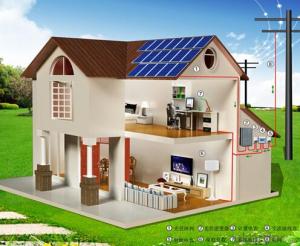CNBM SOLAR Roof Solar System 10000W Popular in Africa
- Loading Port:
- Shanghai
- Payment Terms:
- TT OR LC
- Min Order Qty:
- 1 PCS
- Supply Capability:
- 3000 PCS/month
OKorder Service Pledge
OKorder Financial Service
You Might Also Like
Introduction of Solar Home System
Solar arrays are designed to provide specified amounts of electricity under certain conditions. The following factors are usually considered when determining array energy performance:
Characterization of solar cell electrical performance
Determination of degradation factors related to array design and assembly
Conversion of environmental considerations into solar cell operating temperatures
Calculation of array power output capability.
The amount of electricity required may be defined by any one or a combination of the following performance criteria:
Power output -- power (Watts) available at the power regulator, specified either as peak power or average power produced during one day.
Energy output -- the amount of energy (Watt-hour or Wh) produced during a certain period of time. The parameters are output per unit of array area (Wh/m²), output per unit of array mass (Wh/kg), and output per unit of array cost (Wh/$).
Conversion efficiency -- defined as "energy output from array" ÷ "energy input from sun" × 100%.
This last parameter is often given as a power efficiency, equal to "power output from array" ÷ "power input from sun" × 100%. Power is typically given in units of Watts (W), and energy is typically in units of Wh, or the power in Watts supplied during an hour.
To ensure the consistency and quality of PV systems and increase consumer confidence in system performance, various groups -- such as the Institute of Electrical and Electronics Engineers (IEEE), the International Electrotechnical Commission (IEC), and the American Society for Testing and Materials (ASTM) -- are working on standards and performance criteria for PV systems.
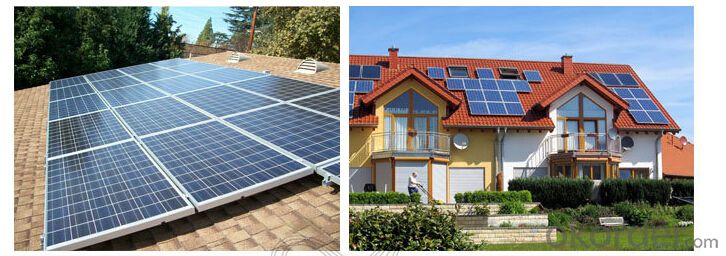


Working Principle of Solar Roof System
The stand alone Solar Home System is an off-grid solar system which uses batteries to store the solar energy. Stand alone solar system solutions design for those who are not able or willing to connect to electricity grid.
Specification of Solar Home System
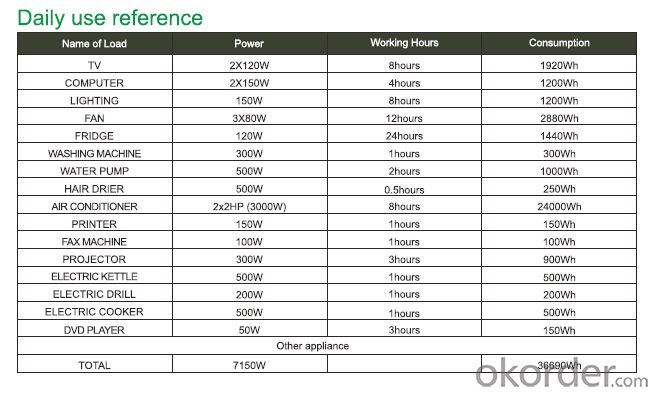
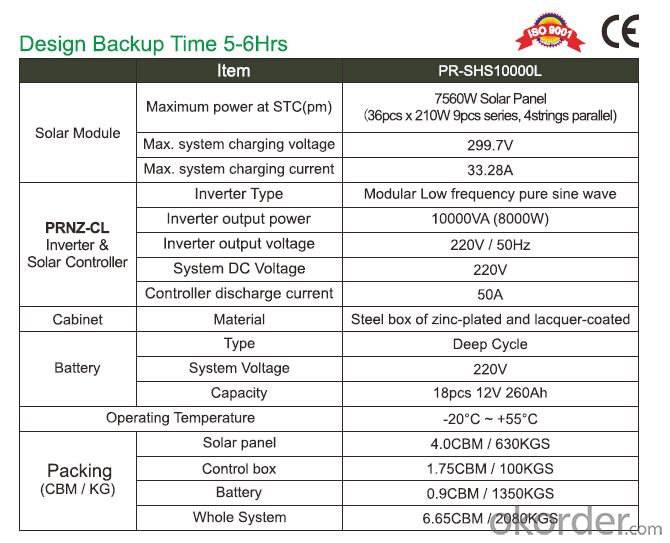
Product Features of Solar Home System
1. Off grid solar power system is mainly used for application with relatively-small power consumption, and the areas have no grid network coverage, or grid power is unstable or outage condition.
2. It’s composed of solar panels, hybrid solar inverter, battery bank, solar panel mounting racks, and other accessories required fora complete home solar power system.
3. The battery bank gives a stable power output to the solar inverter which converts DC to AC to power loads, and provides power backup in rainy or cloudy days.
4. The solar panels generate electricity at daytime and charge the battery bank.
5. The off grid home solar power system provides grid power bypass in case of battery power shortage when sunshine is not enough.
6. All the off grid home solar power system configurations are worked out by scientific calculation and design.
Advantage of Our Solar Home System
1 Excellent Performance: Our Solar Home System is composed by Brand Standard Kits with high quality. Our solar system has the advantage of high efficiency and stable operation. We can ensure our product with a long life period.
2. Small Orders Accepted: We can accept small orders as our customer’s trial order.
3. Warehouse: We have warehouse overseas which can bring great convenience to our customer to pick up the products.
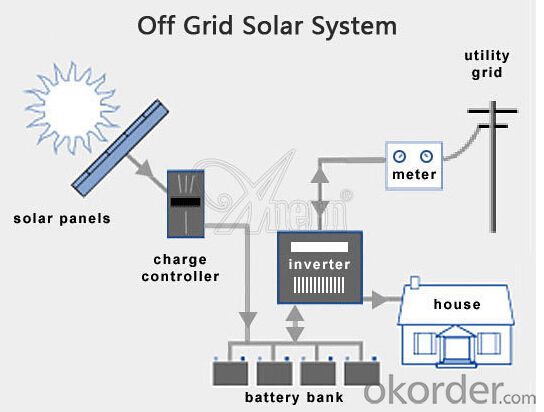
Terms and Conditions
1. Trade terms: FOB Shanghai
2. Payment terms: 30% T/T, balanced before shipment/ LC at sight before shipment. Actual Terms can be negotiated for big order.
3. Package: Exported standard package suitable for tough handling and sea transport.
4. Delivery: Goods to be ready within 10~30 days depending on order quantity.
5. Warranty: 10 years for solar panel, 2 years for controller/inverter/battery.
FAQ
Q: Could you introduce the background of your company?
A: We are a Group corp. with 1GW capacity in China, which is Okorder’s registered VIP Supplier, possess Financial Service from Okorder.com.
Q: Required mainly certificates (CE&IEC/TUV/RoHS)?
A: Our products are certificated by CE RoHS, IEC, ISO, TUV, UL etc.
Q: Your main exported market is?
A: Main markets of our products is: South-east Asia, Mid-east, Arica, East Europe and Latin America.
- Q:What is the role of solar cells in powering off-grid cabins?
- The role of solar cells in powering off-grid cabins is to convert sunlight into electricity, providing a clean and sustainable source of power. Solar cells, also known as photovoltaic cells, capture photons from the sun and generate direct current (DC) electricity. This electricity can then be stored in batteries for use during periods of low sunlight or used directly to power various appliances and systems in the cabin. Solar cells allow off-grid cabins to operate independently from the traditional power grid, reducing reliance on fossil fuels and minimizing environmental impact.
- Q:Which one is better on the solar cells panel? The Monocrystal Solar Energy Cell or photovoltaic cell?
- The photovoltaic cell is better in collecting the sunlight, which means it will be more efficient when the sunlight is better.
- Q:Can solar cells be used in mobile devices?
- Yes, solar cells can be used in mobile devices. In fact, there are already several mobile devices available in the market that are equipped with solar panels to harness solar energy and charge their batteries. These solar-powered mobile devices are particularly useful in situations where access to electricity is limited or unavailable.
- Q:What is the impact of dust and dirt on solar cell performance?
- The presence of dust and dirt on solar cells can significantly impact their performance. These particles can accumulate on the surface of the cells, reducing the amount of sunlight that reaches the photovoltaic material. This reduces the efficiency of the solar cells in converting sunlight into electricity. Dust and dirt can also create shadows on the cells, causing hot spots and leading to uneven distribution of power production. Therefore, regular cleaning and maintenance of solar panels are crucial to maximize their performance and ensure optimal energy generation.
- Q:How do solar cells perform in areas with frequent earthquakes?
- Solar cells can generally perform well in areas with frequent earthquakes as they do not have any moving parts and are not typically affected by ground vibrations. However, it is essential to ensure that the solar panels are properly installed and secured to withstand potential damages caused by seismic activities. Additionally, regular maintenance and inspections may be necessary to ensure the structural integrity of the solar system in earthquake-prone areas.
- Q:Can solar cells be used to power outdoor lighting systems?
- Yes, solar cells can be used to power outdoor lighting systems. Solar cells, also known as photovoltaic cells, convert sunlight into electricity. This electricity can be stored in batteries and used to power outdoor lighting systems, making them energy-efficient and environmentally friendly. Additionally, solar-powered outdoor lighting systems eliminate the need for electrical wiring, making them easy to install and maintain.
- Q:Can solar cells be used in remote locations?
- Yes, solar cells can be used in remote locations. Solar cells generate electricity by converting sunlight into energy, making them suitable for areas with limited access to the power grid or where it might be challenging or expensive to connect to traditional energy sources. They are often deployed in remote locations like rural areas, deserts, mountains, or islands to provide a reliable and sustainable source of power.
- Q:How can I explain to my 10 year old daughter what solar cells are?
- According to Wikipedia: A solar cell, or photovoltaic cell (in very early days also termed "solar battery"[1] – a denotation which nowadays has a totally different meaning, see here), is an electrical device that converts the energy of light directly into electricity by the photovoltaic effect, which is a physical and chemical phenomenon.
- Q:Can solar cells be used for powering remote sensors?
- Yes, solar cells can be used for powering remote sensors. Solar cells convert sunlight into electricity, making them a reliable and sustainable source of power for remote applications. They are commonly used to provide continuous power to sensors in remote locations, where access to the electrical grid may be limited or non-existent.
- Q:Can solar cells be used in remote areas with no grid access?
- Yes, solar cells can be used in remote areas with no grid access. Solar cells convert sunlight into electricity, making them an ideal solution for remote areas where traditional power grids are not accessible. These off-grid solar systems can provide a reliable and sustainable source of electricity for various applications such as lighting, charging small devices, and powering basic appliances. Additionally, advancements in battery storage technology allow excess energy generated during the day to be stored and used during the night, ensuring continuous power supply even in remote areas without grid access.
1. Manufacturer Overview |
|
|---|---|
| Location | |
| Year Established | |
| Annual Output Value | |
| Main Markets | |
| Company Certifications | |
2. Manufacturer Certificates |
|
|---|---|
| a) Certification Name | |
| Range | |
| Reference | |
| Validity Period | |
3. Manufacturer Capability |
|
|---|---|
| a)Trade Capacity | |
| Nearest Port | |
| Export Percentage | |
| No.of Employees in Trade Department | |
| Language Spoken: | |
| b)Factory Information | |
| Factory Size: | |
| No. of Production Lines | |
| Contract Manufacturing | |
| Product Price Range | |
Send your message to us
CNBM SOLAR Roof Solar System 10000W Popular in Africa
- Loading Port:
- Shanghai
- Payment Terms:
- TT OR LC
- Min Order Qty:
- 1 PCS
- Supply Capability:
- 3000 PCS/month
OKorder Service Pledge
OKorder Financial Service
Similar products
New products
Hot products
Related keywords
